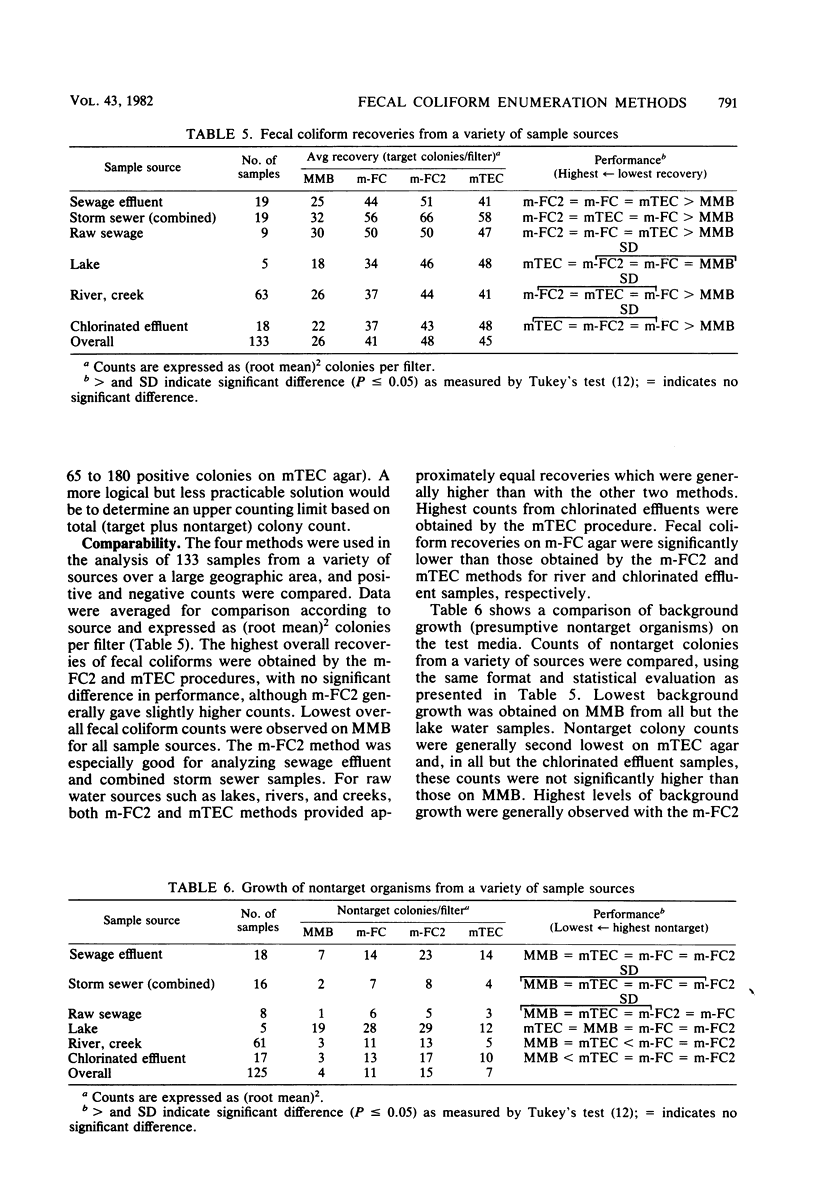Abstract
Four membrane filter methods fecal coliform enumeration were evaluated and compared in six laboratories based on determination of accuracy, specificity, upper counting limit, and recovery comparability. Recovery accuracy with pure cultures ranged from 89 to 100% for m-FC, mTEC (a procedure developed for thermotolerant Escherichia coli), and m-FC2 methods (the latter incorporating a 2-h, 35 degrees C resuscitation period), but was less than 60% for the MacConkey membrane broth method. These figures dropped by approximately 40 to 55% when the cultures were subjected to temperature (10 degrees C) stress. Close to 800 colonies were verified to determine specificity. False-positive colonies occurred most frequently with the m-FC2 method (18%), whereas false-negative colonies were most common on MacConkey membrane broth (26%). In counting range experiments using a variety of samples, the highest upper counting limit was 130 colonies per filter with the mTEC procedure. Recovery comparisons were based on over 130 samples including raw surface waters, raw sewage, and chlorinated and unchlorinated sewage effluents. In general, recoveries were significantly higher with the m-FC2 and mTEC methods; however, on m-FC2, growth of nontarget background organisms was also higher in most cases. Highest recoveries from chlorinated sewage effluents were obtained by the mTEC method, and the addition of a similar resuscitation period to the m-FC procedure (m-FC2) improved fecal coliform recovery from such samples. The best overall performance for fecal coliform enumeration was obtained with the mTEC method with high recovery and low levels of background colonies, good specificity and accuracy, and a high upper counting limit. This procedure also offers the advantage of enumerating E. coli within 24 h.
Full text
PDF






Selected References
These references are in PubMed. This may not be the complete list of references from this article.
- Bissonnette G. K., Jezeski J. J., McFeters G. A., Stuart D. G. Evaluation of recovery methods to detect coliforms in water. Appl Environ Microbiol. 1977 Mar;33(3):590–595. doi: 10.1128/aem.33.3.590-595.1977. [DOI] [PMC free article] [PubMed] [Google Scholar]
- Braswell J. R., Hoadley A. W. Recovery of Escherichia coli from chlorinated secondary sewage. Appl Microbiol. 1974 Aug;28(2):328–329. doi: 10.1128/am.28.2.328-329.1974. [DOI] [PMC free article] [PubMed] [Google Scholar]
- Dufour A. P., Cabelli V. J. Membrane filter procedure for enumerating the component genera of the coliform group in seawater. Appl Microbiol. 1975 Jun;29(6):826–833. doi: 10.1128/am.29.6.826-833.1975. [DOI] [PMC free article] [PubMed] [Google Scholar]
- Dufour A. P., Strickland E. R., Cabelli V. J. Membrane filter method for enumerating Escherichia coli. Appl Environ Microbiol. 1981 May;41(5):1152–1158. doi: 10.1128/aem.41.5.1152-1158.1981. [DOI] [PMC free article] [PubMed] [Google Scholar]
- Green B. L., Clausen E. M., Litsky W. Two-temperature membrane filter method for enumerating fecal coliform bacteria from chlorinated effluents. Appl Environ Microbiol. 1977 Jun;33(6):1259–1264. doi: 10.1128/aem.33.6.1259-1264.1977. [DOI] [PMC free article] [PubMed] [Google Scholar]
- Hufham J. B. Evaluating the membrane fecal coliform test by using Escherichia coli as the indicator organism. Appl Microbiol. 1974 Apr;27(4):771–776. doi: 10.1128/am.27.4.771-776.1974. [DOI] [PMC free article] [PubMed] [Google Scholar]
- Lin S. D. Membrane filter method for recovery of fecal coliforms in chlorinated sewage effluents. Appl Environ Microbiol. 1976 Oct;32(4):547–552. doi: 10.1128/aem.32.4.547-552.1976. [DOI] [PMC free article] [PubMed] [Google Scholar]
- Lin S. Evaluation of coliform tests for chlorinated secondary effluents. J Water Pollut Control Fed. 1973 Mar;45(1):498–506. [PubMed] [Google Scholar]
- Presswood W. G., Strong D. K. Modification of M-FC medium by eliminating rosolic acid. Appl Environ Microbiol. 1978 Jul;36(1):90–94. doi: 10.1128/aem.36.1.90-94.1978. [DOI] [PMC free article] [PubMed] [Google Scholar]
- Rose R. E., Geldreich E. E., Litsky W. Improved membrane filter method for fecal coliform analysis. Appl Microbiol. 1975 Apr;29(4):532–536. doi: 10.1128/am.29.4.532-536.1975. [DOI] [PMC free article] [PubMed] [Google Scholar]
- Rychert R. C., Stephenson G. R. Atypical Escherichia coli in streams. Appl Environ Microbiol. 1981 May;41(5):1276–1278. doi: 10.1128/aem.41.5.1276-1278.1981. [DOI] [PMC free article] [PubMed] [Google Scholar]
- Stuart D. G., McFeters G. A., Schillinger J. E. Membrane filter technique for the quantification of stressed fecal coliforms in the aquatic environment. Appl Environ Microbiol. 1977 Jul;34(1):42–46. doi: 10.1128/aem.34.1.42-46.1977. [DOI] [PMC free article] [PubMed] [Google Scholar]


